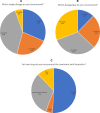Prescribing patterns, indications and adverse events of ibuprofen in children: results from a national survey among Italian pediatricians
- PMID: 33883005
- PMCID: PMC8059227
- DOI: 10.1186/s13052-021-01047-y
Prescribing patterns, indications and adverse events of ibuprofen in children: results from a national survey among Italian pediatricians
Abstract
Background: Despite ibuprofen widely recognized safety profile, an increase of suspected adverse events has been reported in the last decade in parallel with its growing over-the-counter use. The aims of this study were to assess the therapeutic approach to the feverish child and to evaluate the main indications and the most frequent adverse events related to ibuprofen administration in children.
Methods: A specific questionnaire-form regarding the management of ibuprofen therapy in children was distributed among a sample of pediatricians all over the Italian territory between September and October 2020. An electronic data collection through a specifically designed web-based platform was performed among the participating pediatricians.
Results: One-hundred-eighty-one pediatricians completed the survey. In case of fever, 177 (98%) participants prescribe paracetamol, while only 4 (2%) preferred ibuprofen as first choice. One-hundred-twenty-eight pediatricians (71%) administer paracetamol alone, while 53 (29.2%) use the combined/alternating treatment with ibuprofen. Ibuprofen is mostly administered for musculoskeletal pain (30%), upper respiratory tract infection (20%), headache (15%) and post-surgical pain (9%). Sixty-three (35%) out of 181 participating pediatricians reported 191 adverse events during ibuprofen administration. The most common were gastrointestinal (GI), with GI bleeding being reported in 30/191 cases (15.7%), epigastric pain in 29/191 (15.1%), non-specified abdominal pain in 22/191 (11.1%) and nausea/vomiting in 21/191 (11%). Severe adverse events including kidney damage (3.1%), complicated infections (0.5%), pneumonia associated empyema (0.5%), soft tissue infection (0.5%) and disseminated intravascular coagulation (0.5%) were also reported. The adverse events led to a hospitalization in 12% of children. In 53/191 cases (28%) the adverse events were related to a wrong dosage or prolonged therapy or errors in frequency of administration.
Conclusions: This survey demonstrate a sufficient awareness of Italian pediatricians regarding ibuprofen-prescribing patterns with the only possible concern related to the relatively high percentage of pediatricians performing a combining/alternating use of paracetamol and ibuprofen. The reported adverse events were mild in most of the cases and often related to errors in dosage, frequency and treatment duration, emphasizing the need for a major caution of both practitioners and patients in their use.
Keywords: Fever; Ibuprofen; NSAIDs; Pediatrics; Safety.
Conflict of interest statement
The authors declare that they have no competing interests
Figures



Similar articles
-
Acute pain management in children: a survey of Italian pediatricians.Ital J Pediatr. 2019 Dec 3;45(1):156. doi: 10.1186/s13052-019-0754-3. Ital J Pediatr. 2019. PMID: 31796092 Free PMC article.
-
Acute pain management: acetaminophen and ibuprofen are often under-dosed.Eur J Pediatr. 2017 Jul;176(7):979-982. doi: 10.1007/s00431-017-2944-6. Epub 2017 Jun 10. Eur J Pediatr. 2017. PMID: 28600631
-
Alternating antipyretics: is this an alternative?Pediatrics. 2000 May;105(5):1009-12. doi: 10.1542/peds.105.5.1009. Pediatrics. 2000. PMID: 10790455
-
Combined and alternating paracetamol and ibuprofen therapy for febrile children.Evid Based Child Health. 2014 Sep;9(3):675-729. doi: 10.1002/ebch.1978. Evid Based Child Health. 2014. PMID: 25236309 Review.
-
[Focus on the safety of ibuprofen at the analgesic-antipyretic dose].Therapie. 1996 Jul-Aug;51(4):458-63. Therapie. 1996. PMID: 8953831 Review. French.
Cited by
-
Adverse drugs reactions to paracetamol and ibuprofen in children: a 5-year report from a pediatric poison control center in Italy.Ital J Pediatr. 2023 Feb 14;49(1):20. doi: 10.1186/s13052-023-01427-6. Ital J Pediatr. 2023. PMID: 36788576 Free PMC article.
-
Exploring the Cardiovascular Safety Profile of Ibuprofen: Insights from EudraVigilance Database.Pharmaceuticals (Basel). 2025 Jul 17;18(7):1045. doi: 10.3390/ph18071045. Pharmaceuticals (Basel). 2025. PMID: 40732332 Free PMC article.
-
Interpretable machine learning model for early prediction of disseminated intravascular coagulation in critically ill children.Sci Rep. 2025 Apr 2;15(1):11217. doi: 10.1038/s41598-025-91434-w. Sci Rep. 2025. PMID: 40175405 Free PMC article.
References
-
- Neubert A, Verhamme K, Murray ML, Picelli G, Hsia Y, Sen FE, Giaquinto C, Ceci A, Sturkenboom M, Wong IC, TEDDY Network of Excellence The prescribing of analgesics and non -steroidal anti -inflammatory drugs in paediatric primary care in the UK, Italy and the Netherlands. Pharmacol Res. 2010;62(3):243–248. doi: 10.1016/j.phrs.2010.04.006. - DOI - PubMed
MeSH terms
Substances
LinkOut - more resources
Full Text Sources
Other Literature Sources
Medical

